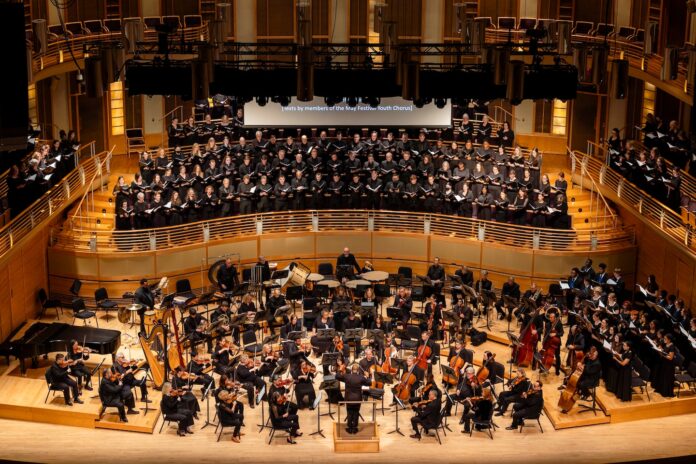Washington Chorus Artistic Director Eugene Rogers delivered a powerhouse turn at the podium leading a fighting-shape Phil in a potent two-part program: the Washington-area premiere of composer James Lee III’s “Breaths of Universal Longings,” a suite in four parts for chorus and orchestra, and an absolutely gripping rendition of Venezuelan composer Antonio Estévez’s “Cantata Criolla,” featuring a pair of blazing performances by tenor Scott Piper and baritone Juan Tomás Martínez Yépez.
Lee’s suite was premiered at the May Festival earlier this year by an assembly of the Cincinnati Symphony Orchestra, the May Festival Chorus and the May Festival Youth Chorus. It opened the festival on a program bookended by Bach’s mighty “Magnificat” (which also received its American premiere at the May in 1875). The symmetry made sense: Both are grand but concise (i.e., 30 minutes or so) and both draw text from the Bible. But most important, both are celebratory works, explicitly concerned with the search for joy and the longing to belong.
Though each of the four movements of “Breaths” takes its texts from distinctly different sources, all share Lee’s entrancing compositional voice: rhythmically adventurous, melodically inviting, given to long stretches of radiant translucence. Rogers led the work with confidence and clarity to match the composer’s.
The first movement (“From Dust We Were Made”) pulls from the books of Genesis and Job, and on Sunday opened with gentle harps, dancing flutes and shimmering cymbals over a current of cello and bass. The Washington Chorus, 170 strong, was bolstered by 29 singers from the Reservoir High School Chamber Choir (led by Gregory Knauf) and still managed to emerge as fine as mist.
The second movement (“Now and Then”), based on a century-old poem by the Missouri poet Charles Bertram Johnson, charts a journey from youth’s “high noon made flight” to “wisdom’s wiser heart”: “All life is built from love, and song is but a part.” The chorus was slightly less crisp, negotiating the slow dissolves of flutes and strings, but these blurred edges didn’t subtract from the movement’s gauzy beauty, the sunlit stairwell of its central theme guiding us out.
Members of the May Festival Youth Chorus penned the lines of the third movement (“Reflection”), which was beautifully handled Sunday by the troupe of young Reservoir singers over a diaphanous wash of strings and searching clarinet. And the finale (“Seeking Joy”), a setting of a poem by Welsh poet William Henry Davies, slyly raises its own stakes (“Joy, how I sought thee!”) by stoking a core of choral anguish. An exciting percussion interlude served to showcase timpanist Thomas Maloy and percussionists Curt Duer, Bill Richards and Donnie Johns.
The closing minutes found the chorus softening into something like snowfall — a feather-light drift that diffused the music’s daylight — before tightening into a forceful, bracing climax. It’s a beautifully balanced suite, suffused with hope without a trace of cloying optimism, and it was a fine use of this formidable chorus.
This energy carried right over into the program’s second half, Estévez’s mythic and mesmerizing “Cantata Criolla: Florentino, el cantó con el Diablo.” Premiered in 1954 in Caracas, Venezuela, and based on a poem by Alberto Avelo Torrealbas, the cantata tells a tale that is part Venezuelan folklore, part Faustian bargain. Florentino, a lone plainsmen, crosses paths with a man in a black hat and black cloak on a black horse — i.e., el Diablo himself.
The Devil (Martínez Yépez) challenges Florentino (Piper) to a singing duel, with his soul as the prize.
Its opening movement (“The Challenge”) opened with darts of flute, blasts of horns and peaks of strings that delivered us into a quiet passage of piano, harp, clarinet, piccolo and the woodblock clip-clop of a lone horse. As the chorus emerged and the exposition unfolded, Rogers demonstrated his multitasking chops: Here the job of the conductor also becomes the burden of the storyteller.
Rogers was ably aided on that front by Martínez Yépez, who emerged quietly from stage left and embodied the voice of evil with appropriately chilling intensity. He has a cannon of a voice and an electric presence — enough so that a small well of worry began to fill in my chest over poor Florentino’s fate. That is, until Piper walked on.
I’m not sure I’ve experienced a more effective walk-on by a singer in D.C. than Piper’s, whose answer as Florentino to the Devil’s challenge unleashed a storm in the form of a gloriously extended “Sabana!” Piper’s voice struck the hall like a bolt of lightning. He accepted the duel, and folks sat up straight in their seats.
The final movement of the cantata finds the two figures squaring off over Estévez’s score, which itself strikes a balance between modernist impulses and reverent nostalgia: Florentino emerges musically through melodic strands of the Gregorian chant “Ave maris stella,” while the Devil manifests through shades of the “Dies Irae.” And throughout, South American rhythms and textures in the orchestra — specifically the joropo — remain in chromatically rich dialogue with the chorus.
The duel itself was action packed, the two singers parrying lines, trading off and building upon each other’s rivaling verses. Piper and Martínez Yépez sang with authority, energy, brute force and good humor. When the chorus rose with a climactic invocation of the Holy Trinity to mark Florentino’s triumph, Rogers guided the orchestra to the thrilling thud of the fallen villain — an ending that sent the Devil right back to hell. Not bad for a Sunday afternoon.



